Organic farming in the forest
- Karen Philippson
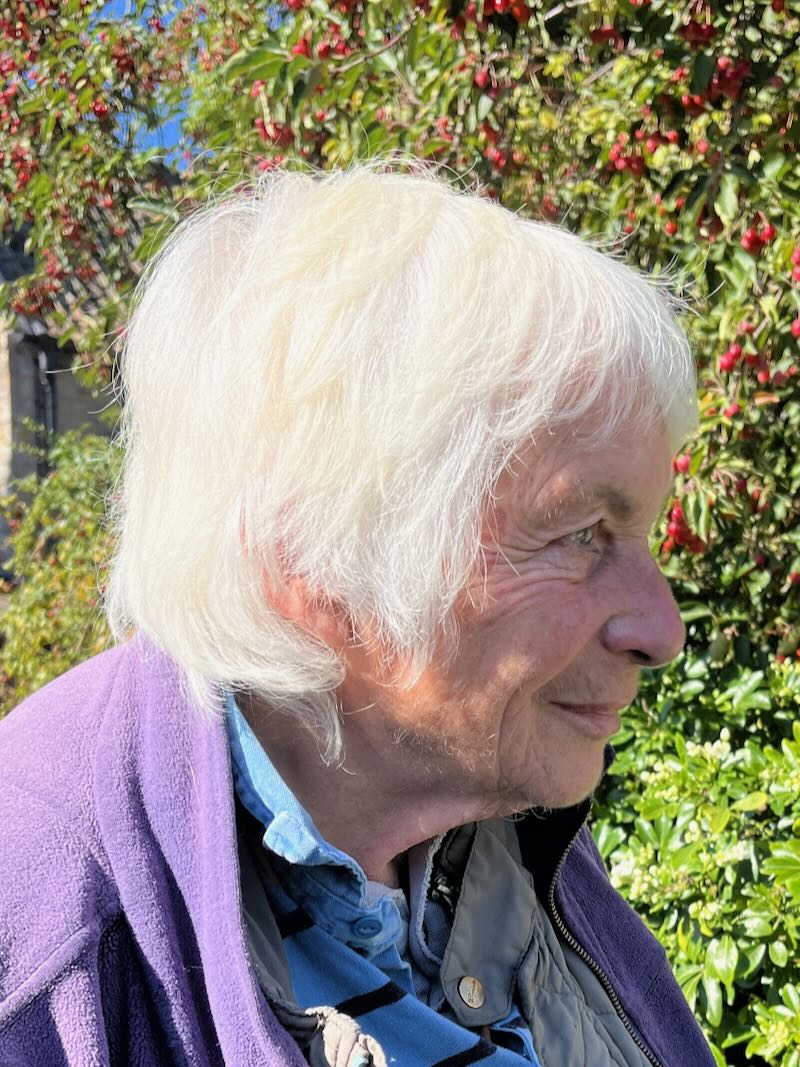
- Sep 25
- 8 min read

Karen Philippson Pollock
Karen lives and works at Aldwinkle Lodge, an all-grass organic farm a couple of miles south of Oundle. In this article she describes the farm and what it means to be farming organically in the 21st century.
All the photos were taken during a visit to the farm in late September when the effects of the very dry summer were still very much in evidence.
About the farm
We started farming at Aldwinkle Lodge in the back end of 1988 and it now extends to about 450 acres. We bought most of it from the Merchant Venturers in July 1988, with additional land purchased from Richard Tarry in 1997. Before we bought it, Geoffrey Bullimore’s father had been the tenant since about 1920 and his son had continued to farm here after his father’s death until he retired in 1988. They had some cattle but it was latterly mainly an arable farm with many of the former hedgerows removed to create huge arable fields.
The farm is surrounded by various Forestry Commission Woods: Souther Wood and Lady
Wood on the west side, Lilford Wood to the north and Wadenhoe Great Wood and Wadenhoe Little Wood in between some of the fields towards the eastern side. The northern edge of the farm is just a field away from Lyveden New Bield. The fields between the woods must have been cleared of trees relatively recently but many of the southern fields, near the village of Wadenhoe are, or were, ridge and furrow, so they must have been cleared for agriculuture for many hundreds of years ago before that.
This extract of an 1822 map of Wadenhoe Parish shows the area that now makes up the northern part of the farm
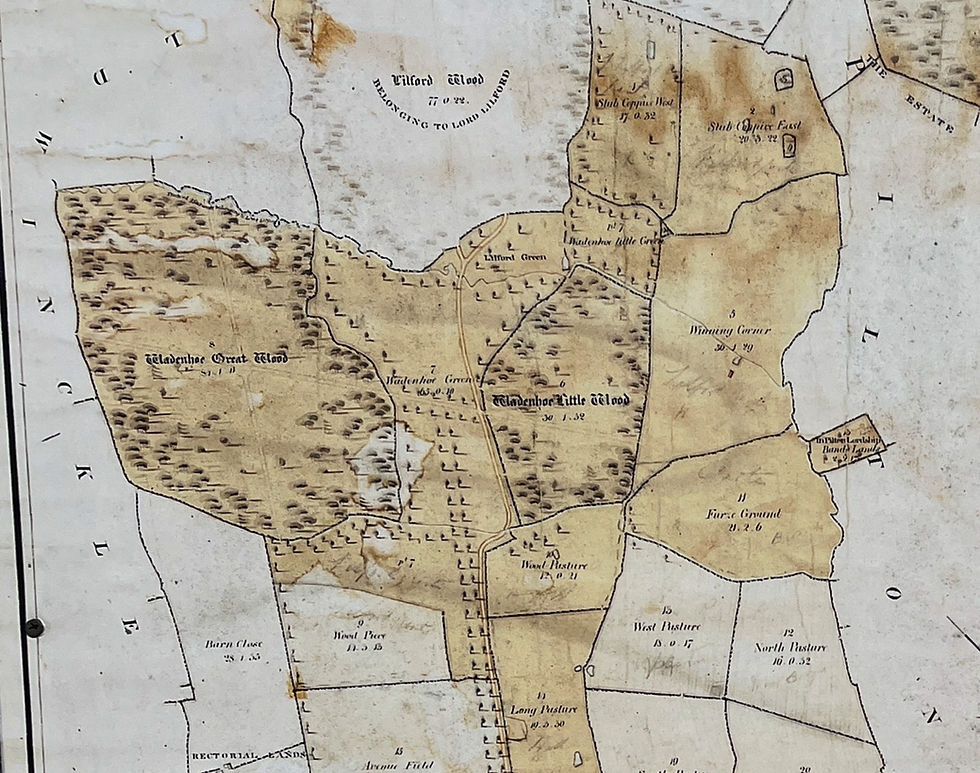

This later 20th century map shows just of part of the farm with the fields that existed before the conversion to arable.
One of the first things we did was to plant 18km or more of hedgerows, trying as best we could to position them as shown on this map so as to re-instate the former field pattern. Where possible we use the former field names too.
Some of these old names include:
Slub Coppice East and West
Furze Ground
Wood Piece Haleys Dyke
Bestground 9 acre
There are good networks of public footpaths all through Souther Wood as well as other rights of way which cross our land. If you walk from Wadenhoe towards Lyveden New Bield, you walk up what is called The Avenue(or Northampton Way). Years ago this must have been the main carriageway from Wadenhoe to Lyveden and beyond, because the hedgerows alongside it are quite straight. As you walk towards Lyveden you come to a crossroads between the two Wadenhoe woods. In the winter when the leaves are off the trees if you look towards Oundle, you can see that the ride is directly in line with St Peter’s Church spire which must have been intentional.
Some of the rights of way are very wide and many of them have metalled tracks
An old historically important stream runs through the farm. The land is all very heavy clay which is not easy to work down for arable. As we are in a very dry area spring arable crops can fail; however, the heavy clay has great water retention advantages for our now all-grass organic farm.
View towards Wadenhoe Great Wood showing the shallow valley and the stream
The heavy Oxford-series clay land is wonderful for oaks. We have many oaks in fields, many grown naturally in hedgerows and we collect the acorns and have grown large numbers to plant around the farm. This year during the drought it has been a great help to have the many trees allowing the animals to have had shade to sit under and some, often very dry, grass to eat.
Why organic?
We had had a small farm in Kent where we lived until we moved here in the summer of 1989. We had acquired Lodge Farm in previous summer but the house needed work and the fields needed fencing. Until we moved here the farm had been farmed conventionally with the use of chemicals. There had been some livestock and the main ridge-and-furrow fields remained in grass, but others had been partly ploughed out, just retaining the slight ridges and furrows and uneven surfaces that had not been worked down. There was very little clover and not much grass.
In Kent I had learned a great deal from the experience of the Mills family who had managed a farm run by Chester Beatty’s son in Wittersham for some years. The Beatty family had helped to found what is now the Cancer Research Centre in London and the then-named Chester Beatty Research Institute in London did work on the effects of chemicals on wildlife and soils, amongst other things. Their farm in Wittersham did a lot of experimental work on arable silage mixes, grassland seed mixes and slightly unconventional methods of farming. They only shallow-ploughed arable fields to keep the topsoil on the surface, unlike much of today’s ploughing which buries the topsoil and brings the subsoil to the surface. They grew hedges and had lots of livestock. In Kent two members of the family advised me and one worked with me as we trialled mixed variety arable and various grass seed mixes. Richard Widdowson, who had worked with Lady Eve Balfour founder of the Soil Association, also helped me with much advice for over 30years.
When we arrived to start work on the Aldwinkle Lodge farm in the autumn of 1988, we had someone plough some fields and we sowed some grass, as well as a mix of peas, grass and arable for silage and just grass on the furthest fields towards Lyveden New Bield.
These last fields proved to be a complete failure with no grass coming up. We had the seed company and the Ministry come and the verdict was that in the past Kerb, a herbicide used for oil seed rape, had been over-applied and this had remained in the soil killing off the grass. I learned then that firstly, working down to plough deeper than 6 inches on this clay soil is very, very time consuming and difficult and to be avoided, and secondly that herbicides leave unwanted legacies in the soil.
Since 1988 we have never sprayed any fields and from 2002, when we became officially organic, we have not applied any fertiliser to the fields other than manure or those inputs sanctioned by Organic Farmers and Growers) who are the certification body for the organic sector.
We have a mixed flock of sheep: Romney, Balwen, Dorset Down and homebred Mashams. In addition we have Beef Shorthorn, Aberdeen Angus and some Northern Dairy Shorthorn x cows and calves. All the animals are born here and are sold direct off-farm to organic purchasers or retained by us for flock and herd replacements. As well as some free-range hens, we also have a group of breeding British Lop pigs, the rarest of the rare breeds.
I firmly believe that animals need to be treated like living, feeling beings: pigs should not be confined to crates or kept on slats with nothing to play with and cows need to be out in fields when they are not damaging the soil structure. If these things mean that the meat costs more, we should just eat less of it, as making animals suffer so that we can have cheap food, unkindly and unhealthily produced is just wrong. It is wrong to treat animals badly and it is wrong to make them suffer so that we can throw food away.
And much the same could be said for vegetables, flour, eggs etc. More and more people are suffering from bad diets with badly produced food with lots of chemical additives. The only ones gaining from this are the chemical companies. Spraying wheat fields with glyphosate pre-harvest was never necessary in the past and should not be necessary now. If people realised that all rapeseed oil and all products containing rapeseed or its oil have been produced from fields sprayed with glyphosate pre-harvest, I wonder if they would be happy to go on eating it or putting it on their salads?
What does it mean to be organic?
Being certified as organic means there are a number of rules with which we must comply. For example, no non-organic female livestock may be brought in that has previously had young.. ie calved, farrowed or lambed. Any non-organic livestock purchases can only be made after a derogation has been granted, which demands a reason for the purchase. In our case, we purchase some hill-bred Swaledales or Blackfaces so that we can produce our own Masham sheep.
The only exception to this strict rule is when there is a rare breed herd needing to be re-homed and an organic farm wishes to provide the animals a home. If cows and calves or ewes and lambs or female pigs are involved those not born on the organic farm cannot be sold as organic, but they can be acquired even though they have calved, lambed or farrowed. No such bought in livestock will itself be able to be sold as organic, but its progeny born on the organic farm will be organic.
No non-organic feed can be fed unless, as possibly in this year of drought, a request ismade to DEFRA and the organic sector body then approves. Even home-milled feed and home-grown hay and silage are tested for any non-approved residues. Nothing other than home-produced manures may be applied to fields without a soil test revealing a specific need for example for lime or salt. This recommendation needs to be science based and either a qualified agronomist or advisor must be able to justify the need to the organic sector body.
All sales of organic livestock or produce must have a valid current organic certificate. For example, if we have eggs or fruit that has been grown on our organic farm, we cannot sell that item as “organically produced and approved” unless it is listed on our approval notice.
All organic farms get a yearly inspection. We have to show that the livestock when housed have adequate space, and must keep complete feed records showing amounts fed and what has been fed. Any critically special antibiotics should not be used other than by a vet in an emergency and all antibiotics and other products have twice the normal withdrawal periods before any animal can be sold for human consumption.
The effect of the drought
As with all farmers in this region and many others in the more southern and eastern areas of the country, the severe drought of this summer has made managing the farm very challenging and difficult.
Most of the field ponds have very little water indeed and some mature oaks are suffering
Normally we go behind the livestock and top excess growth as well as docks and thistles, but this year because of the drought we have tried leaving all the rough or excess grass to shade those grasses still struggling below. This has helped to protect what was left of the grass and has meant that our fields are still full of green grass, though it is very, very dry . The result is that our animals are looking quite reasonable. They have all had hay, feed blocks and mineral blocks on offer but have only begun to eat the hay and the feed blocks when it began to rain.
In a normal year we would only feed lambs for three or four weeks after lambing, but we had to continue feeding the last born lambs and their mothers with organic pellets all through the summer as by the time the last-born ones were put into the fields, the drought had set in.
The only animals we feed pellets or grain to during the summer would normally be the finishing cattle who should be sold in September. But this year we have had to feed all the younger animals to ensure reasonable growth rates over the summer.
All the grazed fields have shade and hedgerows and all fields with livestock have rock salt and mineral buckets and a feed block (not much licked but available).
And finally
Because of its location away from the roads and between the woods, the farm is quite a tranquil place with good numbers of birds, lots of deer (particularly at the moment!) and wonderful views.
Please contact me by email (kop@khayam.org) if you would like to know more.
Views from the farm - south across the Nene Valley and north towards Lyvedon New Bield














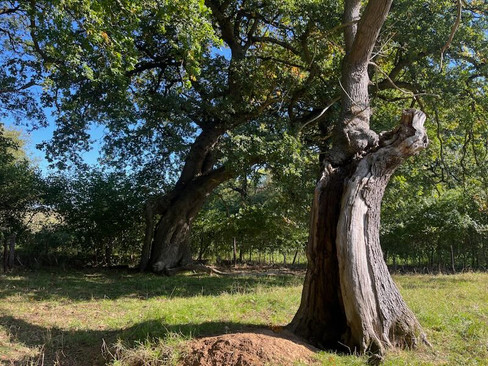





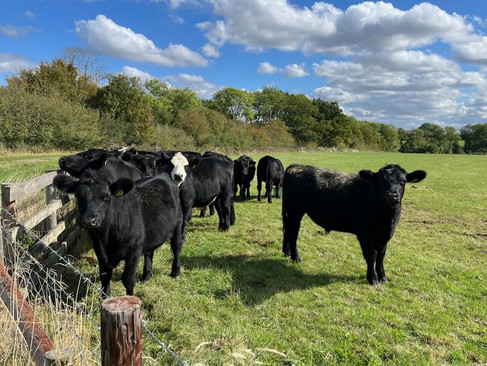



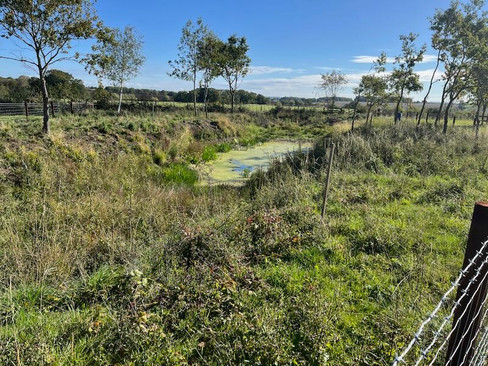









Comments